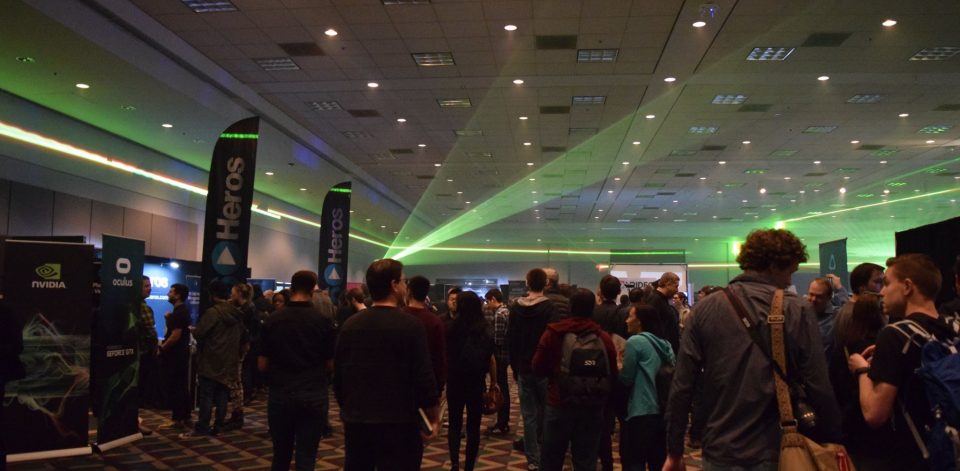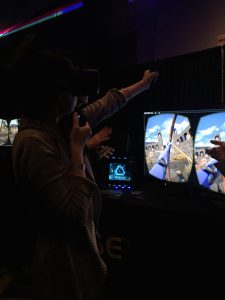
By DSG Group on February 8, 2016
This may stray a bit from your standard academic blog post, but I thought I would share my experiences at the Winter Expo hosted by Virtual Reality Los Angeles last weekend. Since my first exposure to the HTC Vive back in August at Pax Prime, a gaming convention in Seattle, I have been hooked and hungry for more. They actually came by on their campus tour, back in October, to showcase the headset in our very own Rolfe Learning Lab as well. Since the convention hall was dimly lit, I’ll be linking a mix of relevant videos throughout the post instead of solely those recorded from my own device (since my aim isn’t to dissuade people from trying VR).

My first demo of the day was at Sixense where they granted me my childhood dream of becoming a professional archer. I have tried archery before, and your arm starts to get sore after a good chunk of time pulling on the bow string. But with this demo, I felt like I was Robin Hood (on steroids) as I quickly drew out my “arrows” and shot them with ease.
The family in front of me actually brought their 3 year old son to try out the rift. One of the helpers warned the parents beforehand that the headset was marketed towards people 13 years and up since it can prove to be a little disorienting for younger kids. However, this little guy took it like a champ and caught on after his third try. Who knows, VR could be the new ‘Wii’ for family-friendly games.
Granted, VR technology is still relatively new to the scene, so of course there is going to be a certain clunkiness to the overall experience. While wearing the Oculus, I found myself sometimes grazing my own head with the controller when I reached back for more arrows. However, the controllers themselves were intuitive, comfortable, and the designers even tried to implement a slight vibration when you drew your bowstring back.
I made the mistake of trying virZoom next. This has nothing against their company or what they’re trying to accomplish. But it took a toll on my energy for the rest of the day which shows how out of shape I am. You have to ride semi-furiously on a bicycle to move forward in all three demos. The first was being on a horse and lassoing the people riding in front of you, which quickly transitioned into sitting in a race car and racing 4 other AI’s on a racetrack. Lastly, I found myself riding a horse and after collecting a set of wings, I found myself riding a flying horse.
After pedaling for awhile, I figured I would perform a little experiment. And while I was in the air on my flying horse, I completely stopped pedaling. Yes, I survived and I found out that gravity does play a role in the VR world. But what surprised me was when I looked down, I felt my heart skip a beat from seeing how fast the ground was coming towards me. In terms of immersion, even with graphics that aren’t designed to impress an average gamer, this demo does do the trick of giving you a taste of the sense of flight. Of course, I can also attribute my increased heart rate to simply pedaling at an inconsistent rhythm. Overall, the experience was comical, but if they wanted to improve on the interface, I would recommend displaying some sort of meter to track the rpm or indicate how fast a person should pedal. This is because in all three demos, it seemed to be set at different paces and it’s unclear how pedaling in real life transitions to the movement speed in the VR world.

You can find a more detailed description of the experience on Kotaku’s site.
This bonus image on the right, is the Omni-Directional Treadmill by Virtuix. It’s another great way to get people in shape using VR, if you don’t mind looking silly while doing so. The adult-crib device has a circular floor that is built to be very slippery once you put on their customized shoes. The harness helps you keep your balance while the floor simulates running in the VR world.
My absolute favorite demo of the day was by Epic Games and it was called Bullet Train. The premise is a typical FPS (first person shooter) and you are trying to navigate your way around a landing platform while enemies are shooting at you. It felt obvious to me in the game that they must have partnered with Leap Motion, who specialize in tracking hand gestures and motion, because it was extremely accurate. While holding the Oculus Touch controllers, it felt like my hands were seamlessly integrated and mapped into the VR world. Unfortunately, with the Oculus Rift, you are not able to move around like the HTC Vive. However, you can teleport to any location in sight with a button press. While doing so, you can hold down a button on the controller to slow down time.
This is where the cool part comes in… you can pick up the enemy bullets that are flying towards you and throw it back into their faces. I’m serious, it felt like I was in the Matrix. With the Unreal Engine 4, the graphics were drop-dead gorgeous. This demo definitely produces a wow-factor when you combine the immersive graphics with comprehensive controller functionality.
While standing in line for another demo, I was greeted by a producer from KCRW who mentioned his desire to implement and improve upon 360-technology to create a more immersive experience for music fans. Even while I was walking to another demo booth, I overheard a group of academics who were talking about using students’ Sketchup models and having them be able to explore and walk around it using VR.
Virtual Reality is not an abstract idea of the past anymore, nor is it meant to be a tool that is reserved exclusively for the gaming community. Its potential has garnered the attention of entrepreneurs from almost every industry. That being said, after speaking to one of the coordinators at VRLA, the reason why most virtual reality demos are game-related is to showcase the flashy nature of this technology. Without the support of the gaming community, VR would not have become this popular this quickly. However, as these headsets become more accessible to the public, it is without a doubt that VRLA would love to include other parties who can showcase the wide range of uses with VR, which most definitely includes the educational aspect.
As I was leaving, there was one memorable moment where I saw a woman at the Walking Dead demo. You could clearly see the smile on her face from across the hall as she waved her mock-gun around wildly while seated in her wheelchair. These sort of images have led me to appreciate the undeniable positives that VR technology can bring when you aren’t constrained to the limits of this reality. Hopefully in the near future, we’ll be seeing more projects changing the way people can learn about historical spaces, pushing the limits of behavioral therapy, and shaping the future of multimedia.
Photos & Videos taken by Jonathan Yang, a past HumTech Lab Consultant
Joy Guey is the Lab Operations Manager at the UCLA Center for Digital Humanities, and helps Anthony Caldwell manage the HumTech Learning Lab @ Rolfe. She recently graduated from UCLA in Psychology and Digital Humanities, and is seeking opportunities to collaborate in the mixed reality industry. “As a long-time gamer and a virtual reality enthusiast, it has excited me to see the trajectory of VR and its potential to revolutionize the way we perceive media today.”
Resources
- Winter Expo (http://www.virtualrealityla.com/expo/)
- HTC Vive (https://www.htcvive.com/us/)
- Oculus Rift (https://www.oculus.com/en-us/)
- Kotaku (http://kotaku.com/sony-s-vr-headset-turned-me-into-a-flying-horse-1712342518)
- Bullet Train (https://www.youtube.com/watch?feature=player_embedded&v=DmaxmnPzMWE)
- Leap Motion (https://www.leapmotion.com/)
- 360 – Death Cab for Cutie Performance (https://www.youtube.com/watch?feature=player_embedded&v=yzh_oRXVm3I)
